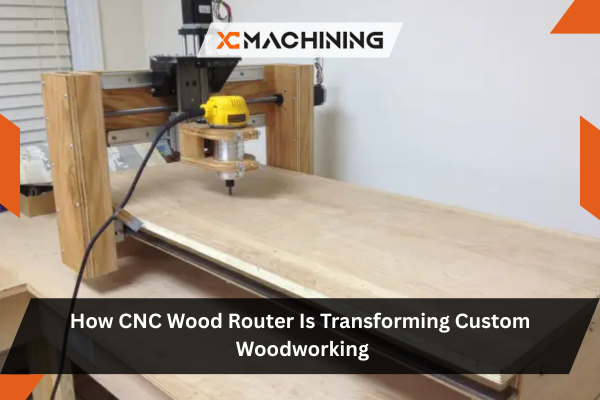Have you ever wanted to create beautiful, custom wooden pieces without spending hours on tricky cuts and endless sanding? Maybe you’ve tried your hand at woodworking, only to feel overwhelmed by the precision required. If this sounds familiar, you’re not alone. Many people struggle to achieve that perfect finish or the intricate details they dream of when shaping wood. They’re often left wondering if there’s a faster, more accurate way to bring their wooden creations to life.
In this article, we’ll explore exactly how a CNC wood router works, why it’s become a game-changer for custom woodworking, and how you can get started without getting lost in technical jargon. We’ll also cover practical tips, budgeting considerations, and real-life examples of how these machines are taking the woodworking world by storm.
Why CNC Wood Routers Matter ?
CNC wood routers matter because they combine precision, speed, and versatility into one powerful tool. Instead of relying on purely manual methods, they automate complex cuts, carvings, and engravings. As a result, woodworkers—both beginners and pros—can produce high-quality pieces in less time, with fewer errors and less waste.
Versatility
From small decorative trinkets to large-scale furniture pieces, a CNC wood router handles them all. You’re not limited to simple shapes; you can create ornate designs, engravings, and detailed patterns. This flexibility frees your imagination to explore endless woodworking possibilities.
Efficiency
Time is money, and efficiency matters. Instead of manually cutting each piece, let the CNC machines do the heavy lifting. A CNC wood router can replicate designs rapidly, ensuring each cut or carve is consistent, which makes mass production easier and more profitable.
Accessibility
CNC technology might sound intimidating, but modern routers are surprisingly user-friendly. Many come with software that simplifies design. Whether you’re new or a seasoned woodworker, you can quickly learn the basics and start bringing your creative visions to life with minimal hassle.
The Rise Of Automated Precision
A few decades ago, carpenters relied heavily on handheld tools and manual measurements. Each piece was a labor of love but also a labor of time. Today, the landscape has shifted dramatically. Automated tools, especially the CNC wood router, have allowed craftspeople to produce designs with laser-like precision machining.
Why does this matter? In a fast-paced world, consumers want custom products without lengthy wait times. With automated machines, intricate patterns, and repeated cuts can be done in a fraction of the time. This evolution opens doors for both hobbyists and professional workshops to stay competitive and innovative.
Fact Box
CNC stands for “Computer Numerical Control.” It means a computer guides the movements of the router, ensuring extreme accuracy in every cut.

Key Components Of A CNC Wood Router
Understanding the main parts of a CNC wood router helps you use the machine effectively. Though it might look like a complex contraption, most CNC routing share these essential components:
- Spindle: The cutting or carving component that does the actual work on your wood.
- Bed/Table: The surface where you place your material.
- Stepper Motors: Control the movement of the spindle along the X, Y, and Z axes.
- Controller and Software: The “brain” interprets your design instructions into precise motions.
- Frame: Holds everything together and keeps the device sturdy.
Each component plays a role in the final cut’s precision. If one part is off, the accuracy of the entire project suffers. That’s why understanding these elements—and ensuring they’re in good shape—is crucial for top-quality results.
Suggestion Box
Regularly check your stepper motors and spindle alignment. A slight shift in alignment can lead to major errors down the line.
Preparing Your Workshop For A CNC Wood Router
Before you bring home a CNC wood router, make sure your workspace is ready. These machines, while not always huge, still need enough room to move freely. You’ll want to plan for:
- Adequate Space: Ensure at least a few feet of clearance around the machine.
- Stable Power Supply: Most CNC router machine need a standard voltage, but check the requirements.
- Ventilation: Wood dust can pile up quickly, so an extraction system or vacuum port is a must.
- Sturdy Table or Base: A shaky stand can produce inaccurate cuts.
Make sure your workshop is well-lit. Visibility is key to spotting any issues before they become bigger problems.
Danger Box: Sawdust can be explosive in certain concentrations. Always keep your working area clear of excess dust, and never ignore recommended dust collection systems.
Common Mistakes Beginners Make
When you’re new to CNC woodworking, it’s easy to get overly excited and dive right in. However, a few common pitfalls can derail your progress. Here’s how to avoid them:
- Skipping Test Runs: Always do a test run on scrap wood first.
- Ignoring Tool Wear: Dull bits lead to rough edges and can strain your machine.
- Overlooking Maintenance: Regular cleaning and lubrication prevent mechanical issues.
- Rushing Setup: Take time to properly secure the material and calibrate the router.
- Neglecting Safety Gear: Wear goggles and masks for dust protection.
By staying mindful of these points, you’ll save both time and resources. Mistakes happen, but learning from them quickly will help you become confident with your CNC wood router.
Table: Quick Comparison Of CNC Wood Router Features
Below is a simple table that shows a quick comparison of three popular CNC wood router models for entry-level users. This table aims to help you spot key differences at a glance.
| Feature | Model A | Model B | Model C |
|---|---|---|---|
| Work Area | 12″ x 12″ x 3″ | 24″ x 24″ x 4″ | 30″ x 30″ x 5″ |
| Spindle Power | 300W | 500W | 800W |
| Software | Basic Included | Basic Included | Advanced Bundle |
| Price Range | $500 – $700 | $800 – $1,200 | $1,300 – $1,800 |
| Ideal User Level | Beginner | Beginner/Intermediate | Intermediate |
Info: These pricing ranges are approximate.
Choosing The Right Software For Your Needs
Once you have a CNC wood router, you’ll need software to create or import designs. This software tells the machine how to move, where to cut, and how deep to go. For beginners, user-friendly programs like Carve or Easel can be a good start. They offer drag-and-drop interfaces and plenty of tutorials.
If you’re more advanced, you might explore Fusion 360 or SolidWorks for 3D printing. These programs come with robust feature sets, but they also have steeper learning curves. Decide on a program based on your comfort with technology and the complexity of the projects you plan to undertake.
Quick Tip
Practice using sample files first. Most software packages include free designs or demo files that let you learn the ropes without risking valuable materials.
Maintenance Tips For Prolonged Performance
Keeping your machine in top shape is crucial for consistent, high-quality results. Think of your CNC wood router like a car—maintenance might feel tedious, but it saves you headaches in the long run.
- Clean After Each Use: Dust and debris can build up quickly, affecting moving parts.
- Lubricate Rails: This prevents friction and ensures smoother movement along the axes.
- Tighten Screws: Vibrations can loosen bolts and screws over time, so do regular checks.
- Check Bits/Tools: Replace or sharpen dull bits to avoid uneven cuts.
- Update Software: Many manufacturers release firmware or software updates to fix bugs and improve performance.
A little care goes a long way. Consistent maintenance means you’ll enjoy accurate cuts and fewer machine breakdowns for years to come.
Safety Measures To Keep In Mind
Woodworking can be a blast, but it also comes with risks. A CNC wood router is powerful and should be treated with respect. Always wear protective eyewear and a dust mask to shield yourself from flying debris. If you’re dealing with large sheets of wood, consider having a friend around to help you load and unload materials safely.
Double-check that your emergency stop button works properly. If something goes wrong, you need to halt the machine fast. Also, keep children and pets away from the router when it’s operating. The last thing you want is a curious hand in a risky spot.
Warnings: Never bypass safety interlocks or remove protective shields. Doing so can lead to serious injuries.
Real-World Examples Of CNC Woodworking
One of the best ways to understand the impact of a CNC wood router is to look at real-world success stories. Let’s take a small custom sign shop, for instance. They started out hand-carving names on plaques. It was a slow process, and orders piled up quickly. After investing in a CNC wood router, they were able to crank out the same designs in half the time, with consistent quality in every sign. They even expanded their offerings to include intricate graphics and logos.
Another example is a local furniture maker who specializes in personalized chairs and tables. By automating certain steps, they could take on more custom orders without sacrificing detail. Customers were thrilled to receive pieces that looked hand-carved but were delivered faster and often at a lower cost. These stories highlight why many small businesses see CNC routers as an investment that pays for itself.
The Environmental Impact
Wood is a renewable resource, but responsible manufacturing is key to ensuring we don’t harm our forests. A CNC wood router can help reduce waste because it cuts more accurately, requiring fewer materials to get the job done. Precision also means you’re less likely to mess up a piece of wood halfway through and discard it.
Additionally, many workshops recycle or repurpose sawdust, turning it into wood pellets or using it for compost. By optimizing cuts and reducing scrap, CNC technology can be a boon for eco-conscious woodworkers. The planet benefits from less waste, and you benefit from cost savings on materials.
Cost And Budget Planning
Let’s face it—CNC routers aren’t the cheapest pieces of equipment out there. Prices can range from a few hundred dollars for a small, hobby-grade machine to several thousand for professional units. However, a well-chosen CNC wood router can pay for itself over time through increased efficiency, reduced labor costs, and the ability to take on more complex jobs.
Remember to factor in software expenses, replacement bits, and potential upgrades down the line. Budget for unexpected costs, too. Maybe you’ll need a dust collection system or an upgraded power supply. Planning for these expenses ahead of time will help you make a wise, long-term investment.
Fact: According to a 2022 market report by Fortune Business Insights, the global CNC machine tools market is expected to grow significantly in the coming years, suggesting that more affordable and advanced models might become available.
The Future Of CNC Wood Routers
Technology moves quickly, and CNC design are no exception. We’re already seeing trends like:
- Smart Sensors: Machines that automatically adjust speeds and feeds for optimal cutting.
- Enhanced Connectivity: Cloud-based software allows for remote monitoring and job scheduling.
- Materials Expansion: Many CNC routers can now handle foam, plastic, and even light metals, expanding creative possibilities.
As these innovations take hold, expect CNC routers to become even more integral in small workshops and large manufacturing plants alike. Soon, you might even find fully automated systems that handle loading, cutting, and finishing with minimal human input. This progression promises even greater speed, accuracy, and creative freedom for woodworkers everywhere.

Conclusion
A CNC wood router is more than just another power tool—it’s a game-changer for woodworkers of all skill levels. By combining computer-driven precision with traditional craftsmanship, these machines open up possibilities that were once too time-consuming or expensive to attempt. Whether you’re a hobbyist looking to dabble in new projects or a professional aiming to scale your business, the benefits are clear: enhanced accuracy, faster production, and limitless design potential.
Still wondering if it’s right for you? Think of it this way: if you value creativity, efficiency, and consistency, a CNC router can bring all three to your workshop. Sure, there’s a learning curve and an upfront cost. But many find that the machine quickly justifies itself through time savings and the sheer joy of being able to craft anything you can imagine.
FAQ
Is it hard to learn how to use a CNC wood router?
It might seem daunting at first, but many beginners find the software and machine controls straightforward once they try a few practice projects.
Do I need advanced math skills to operate the router?
Not really. Basic math can help with measurements and design, but most software handles complex calculations automatically.
Can I work with metals using my CNC wood router?
Some routers can handle soft metals like aluminum or brass, but you’d need the right bits and speeds. Always check your machine’s specifications first.





